 W
WAnostraca is one of the four orders of crustaceans in the class Branchiopoda; its members are also known as fairy shrimp. They live in vernal pools and hypersaline lakes across the world, and they have even been found in deserts, ice-covered mountain lakes and Antarctic ice. They are usually 6–25 mm (0.24–0.98 in) long. Most species have 20 body segments, bearing 11 pairs of leaf-like phyllopodia, and the body lacks a carapace. They swim "upside-down" and feed by filtering organic particles from the water or by scraping algae from surfaces. They are an important food for many birds and fish, and some are cultured and harvested for use as fish food. There are 300 species spread across 8 families.
 W
WBrine shrimp have the ability to produce dormant eggs, known as cysts. This has led to the extensive use of brine shrimp in aquaculture. The cysts may be stored for long periods and hatched on demand to provide a convenient form of live feed for larval fish and crustaceans.
 W
WArchaebranchinecta barstowensis is a species of fairy shrimp (Anostraca) that inhabited California during the Middle Miocene. Its fecal material is abundant in the concretions from the Barstow Formation. A limited number of whole specimens have been found, and they represent the "best-preserved fossil anostracan known to date". The closest relative of A. barstowensis appears to be Archaebranchinecta pollicifera from the surroundings of Lake Titicaca, and the two have been separated from the genus Branchinecta as the new genus Archaebranchinecta.
 W
WArtemia is a genus of aquatic crustaceans also known as brine shrimp. Artemia, the only genus in the family Artemiidae. The first historical record of the existence of Artemia dates back to the first half of the 10th century AD from Urmia Lake, Iran, with an example called by an Iranian geographer an "aquatic dog", although the first unambiguous record is the report and drawings made by Schlösser in 1757 of animals from Lymington, England. Artemia populations are found worldwide in inland saltwater lakes, but not in oceans. Artemia are able to avoid cohabiting with most types of predators, such as fish, by their ability to live in waters of very high salinity.
 W
WArtemia franciscana is a species of brine shrimp endemic to the Americas but now widely introduced throughout the tropics and temperate zones worldwide.
 W
WArtemia monica, the Mono Lake brine shrimp, is a species of brine shrimp, endemic to Mono Lake in California, United States.
 W
WArtemia parthenogenetica is a species of brine shrimp – aquatic crustaceans belonging to a different class, the Branchiopoda, than the true shrimps.
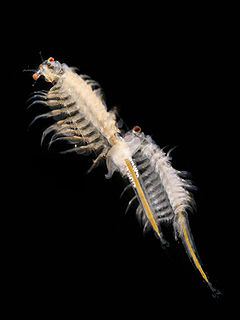 W
WArtemia salina is a species of brine shrimp – aquatic crustaceans that are more closely related to Triops and cladocerans than to true shrimp. It belongs to a lineage that does not appear to have changed much in 100 million years.
 W
WArtemia is a genus of aquatic crustaceans also known as brine shrimp. Artemia, the only genus in the family Artemiidae. The first historical record of the existence of Artemia dates back to the first half of the 10th century AD from Urmia Lake, Iran, with an example called by an Iranian geographer an "aquatic dog", although the first unambiguous record is the report and drawings made by Schlösser in 1757 of animals from Lymington, England. Artemia populations are found worldwide in inland saltwater lakes, but not in oceans. Artemia are able to avoid cohabiting with most types of predators, such as fish, by their ability to live in waters of very high salinity.
 W
WBranchinecta is a genus of crustacean in family Branchinectidae. It includes around 50 species, found on all continents except Africa and Australia. Branchinecta gigas, the giant fairy shrimp, is the largest species in the order, with a length of up to 10 centimetres (4 in), and Branchinecta brushi lives at the highest altitude of any crustacean, at 5,930 metres (19,460 ft), a record it shares with the copepod Boeckella palustris. A new genus, Archaebranchinecta was established in 2011 for two species previously placed in Branchinecta.Branchinecta achalensis Cesar, 1985 Branchinecta belki Maeda-Martínez, Obregón-Barboza & Dumont, 1992 Branchinecta brushi Hegna & Lazo-Wasem, 2010 Branchinecta campestris Lynch, 1960 – pocket-pouch fairy shrimp Branchinecta coloradensis Packard, 1874 – Colorado fairy shrimp Branchinecta constricta Rogers, 2006 Branchinecta conservatio Eng, Belk & Eriksen, 1990 – conservancy fairy shrimp Branchinecta cornigera Lynch, 1958 – horned fairy shrimp Branchinecta dissimilis Lynch, 1972 – Great Basin fairy shrimp Branchinecta ferox (M. Milne-Edwards, 1840) Branchinecta gaini Daday, 1910 Branchinecta gigas Lynch, 1937 – giant fairy shrimp Branchinecta granulosa Daday, 1902 Branchinecta hiberna Rogers & Fugate, 2001 – winter fairy shrimp Branchinecta iheringi Lilljeborg, 1889 Branchinecta kaibabensis Belk & Fugate, 2000 – Kaibab fairy shrimp Branchinecta lateralis Rogers, 2006 Branchinecta leonensis Cesar, 1985 Branchinecta lindahli Packard, 1883 – versatile fairy shrimp Branchinecta longiantenna Eng, Belk & Eriksen, 1990 – longhorn fairy shrimp Branchinecta lynchi Eng, Belk & Eriksen, 1990 – vernal pool fairy shrimp Branchinecta mackini Dexter, 1956 – alkali fairy shrimp Branchinecta mediospina Rogers, Dasis & Murrow, 2011 Branchinecta mesovallensis Belk & Fugate, 2000 – mid-valley fairy shrimp Branchinecta mexicana Maeda-Martínez, Obregón-Barboza & Dumont, 1992 Branchinecta minuta Smirnov, 1948 Branchinecta oriena Belk & Rogers, 2002 Branchinecta orientalis G. O. Sars, 1901 Branchinecta oterosanvicentei Obregón-Barboza, et al., 2002 Branchinecta packardi Pearse, 1912 – Packard fairy shrimp Branchinecta paludosa (O. F. Müller, 1788) – circumpolar fairy shrimp Branchinecta palustris Birabén, 1946 Branchinecta papillosa Birabén, 1946 Branchinecta potassa Belk, 1979 – Nebraska fairy shrimp Branchinecta prima Cohen, 1983 Branchinecta raptor Rogers, Quinney, Weaver, and Olesen 2006 Branchinecta readingi Belk, 2000 – Reading fairy shrimp Branchinecta rocaensis Cohen, 1982 Branchinecta sandiegonensis Fugate, 1993 – San Diego fairy shrimp Branchinecta serrata Rogers, 2006 Branchinecta somuncurensis Cohen, 1983 Branchinecta tarensis Birabén, 1946 Branchinecta tolli (G. O. Sars, 1897) Branchinecta valchetana Cohen, 1981 Branchinecta vuriloche Cohen, 1985
 W
WBranchinectidae is a family in the order Anostraca, containing two genera – Branchinecta and Archaebranchinecta. The majority of the species are in the genus Branchinecta, with only Archaebranchinecta pollicifera and the fossil Archaebranchinecta barstowensis in the second genus.
 W
WBranchinella is a genus of crustaceans in the family Thamnocephalidae. This fairy shrimp genus is found across many parts of the world, but especially western Australia and southern Africa.
 W
WBranchipodidae is a family of fairy shrimp, one of eight in the order Anostraca. It contains 35 extant species in five extant genera:Branchipodopsis G. O. Sars, 1898 Branchipus Schaeffer, 1766 Metabranchipus Masi, 1925 Pumilibranchipus Hamer & Brendonck, 1995 Rhinobranchipus Brendonck, 1995
 W
WBranchipodopsis is a genus of aquatic crustaceans, in the order Anostraca. It is one of several genera known as fairy shrimp. All described species are specialised for inhabiting ephemeral rock pools in situations such as mountains and deserts. Though the genus is most widely known from Africa, some occur in the middle east and adjoining regions.
 W
WArtemia is a genus of aquatic crustaceans also known as brine shrimp. Artemia, the only genus in the family Artemiidae. The first historical record of the existence of Artemia dates back to the first half of the 10th century AD from Urmia Lake, Iran, with an example called by an Iranian geographer an "aquatic dog", although the first unambiguous record is the report and drawings made by Schlösser in 1757 of animals from Lymington, England. Artemia populations are found worldwide in inland saltwater lakes, but not in oceans. Artemia are able to avoid cohabiting with most types of predators, such as fish, by their ability to live in waters of very high salinity.
 W
WChirocephalidae is a family of fairy shrimp, characterised by a reduced or vestigial maxilla, more than two setae on the fifth endite, divided pre-epipodites and widely separated seminal vesicles. It consists of the following eight genera, including the genera formerly placed in the families Linderiellidae and Polyartemiidae:Artemiopsis G. O. Sars, 1897 Branchinectella Daday de Dées, 1910 Chirocephalus Prévost, 1820 Dexteria Brtek, 1965 Eubranchipus Verrill, 1870 Linderiella Brtek, 1964 Polyartemia Fischer, 1851 Polyartemiella Daday de Dées, 1909
 W
WChirocephalus is a genus of fairy shrimp in the family Chirocephalidae. It contains the following species:
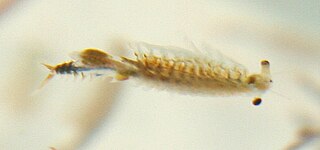 W
WChirocephalus croaticus is a species of fairy shrimp in the family Chirocephalidae. It is found only in Croatia and Slovenia and is listed as a vulnerable species on the IUCN Red List.
 W
WChirocephalus diaphanus is a widely distributed European species of fairy shrimp that lives as far north as Great Britain, where it is the only surviving species of fairy shrimp and is protected under the Wildlife and Countryside Act 1981. It is a translucent animal, about 0.5 in (13 mm) long, with reddened tips to the abdomen and appendages. The body comprises a head, a thorax bearing 11 pairs of appendages, and a seven-segmented abdomen. In males, the antennae are enlarged to form "frontal appendages", while females have an egg pouch at the end of the thorax.
 W
WChirocephalus marchesonii is a species of fairy shrimp in the family Chirocephalidae. It is endemic to Pilate Lake.
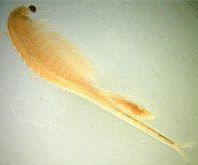 W
WThe conservancy fairy shrimp is a small crustacean in the family Branchinectidae. It ranges in size from about 1.25 centimetres (0.49 in) to 2.5 centimetres (0.98 in) long. Fairy shrimp are aquatic species in the order Anostraca. They have delicate elongate bodies, large stalked compound eyes, no carapaces, and eleven pairs of swimming legs. They glide gracefully upside down, swimming by beating their legs in a complex, wavelike movement that passes from front to back. Fairy shrimp feed on algae, bacteria, protozoa, rotifers and detritus. This species is endemic to California in the United States.
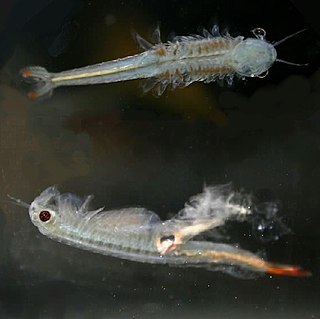 W
WDendrocephalus is a genus of fairy shrimp found in South and North America. It is characterised by the presence of an antenna-like appendage arising between the second antennae and the eyestalks. The genus comprises 16 species in two subgenera:Dendrocephalus Daday, 1908Dendrocephalus affinis Pereira, 1984 – Venezuela Dendrocephalus argentinus Pereira & Belk, 1987 – Paraguay Dendrocephalus brasiliensis Pesta, 1921 – Argentina, Brazil Dendrocephalus cervicornis (Weltner, 1890) – Argentina Dendrocephalus conosurius Pereira & Ruiz, 1995 Dendrocephalus cornutus Pereira & Belk, 1987 – Costa Rica Dendrocephalus geayi Daday, 1908 – Venezuela Dendrocephalus goiasensis Rabet & Thiéry, 1996 – Brazil Dendrocephalus orientalis Rabet & Thiéry, 1996 – Brazil Dendrocephalus sarmentosus Pereira & Belk, 1987 – Galápagos Islands Dendrocephalus spartaenovae Margalef, 1967 – Venezuela Dendrocephalus thieryi Rabet, 2006 – Brazil Dendrocephalus venezolanus Pereira, 1984 – VenezuelaDendrocephalinus Rogers, 2006Dendrocephalus acacioidea (Belk & Sissom, 1992) – United States Dendrocephalus alachua (Dexter, 1953) – United States Dendrocephalus lithaca Creaser, 1940 – United States
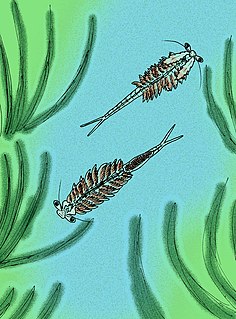 W
WDexteria floridana is an extinct species of fairy shrimp in the family Chirocephalidae, the only species in the genus Dexteria. It was endemic to Florida, where it was known from a single pool, south of Gainesville. It was originally described by Ralph W. Dexter in 1953 as a species of Eubranchipus. The species was declared extinct on October 5, 2011 because it was found that the only known pool of water that contained the known population was filled in for development, thereby killing the shrimps.
 W
WEubranchipus is a genus of brine shrimp and fairy shrimp in the family Chirocephalidae. There are about 16 described species in Eubranchipus.
 W
WParartemia is a genus of brine shrimp endemic to Australia. One species, P. contracta is listed as vulnerable on the IUCN Red List. Parartemia contains the following species:
 W
WStreptocephalus woottoni, with the common name Riverside fairy shrimp, is a rare species of crustacean in the family Streptocephalidae. It is native to Southern California in the United States, and northern Baja California in northwest Mexico.
 W
WStreptocephalus is a genus of fairy shrimp found in temporary waters in Africa, Australia, Eurasia, and Central and North America, following its ancient origin in Gondwana. It contains the following species:
 W
WStreptocephalus sirindhornae is a species of crustacean in the family Streptocephalidae; a genus of freshwater dwelling shrimp belonging to the Anostraca order of Branchiopoda. It is endemic to Thailand, and it was named after Princess Sirindhorn.
 W
WTanymastigidae is a family of fairy shrimp. It contains two genera:Tanymastigites Tanymastix
 W
WTanymastix is a genus of anostracan crustaceans, characterised by their lenticular (lentil-shaped) eggs. It comprises three species. Tanymastix stagnalis has a wide distribution across Europe and North Africa. T. motasi is endemic to Romania and North Macedonia, while T. stellae was endemic to Sardinia. The type locality of T. stellae has since been destroyed and the species is believed to be extinct; reports of T. stellae surviving on Corsica have not been confirmed, despite repeated attempts.
 W
WTanymastix stagnalis is a species of Anostraca that lives in temporary pools across Europe. It may reach up to 2 cm (0.8 in) in some areas and has 11 pairs of bristly, flattened appendages. It swims upside-down and filters food particles from the water. It is the only species of Anostraca in Ireland, having been discovered in Rahasane turlough in 1974.
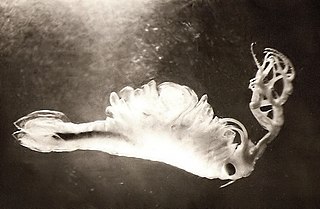 W
WThamnocephalidae is a family of crustaceans with wide distribution including Western Australia, Southern Africa and South America. It was originally described as a subfamily of Branchipodidae by Alpheus Spring Packard in 1883, and elevated to the rank of family by Simon in 1886. Six genera are recognised, in two subfamilies:ThamnocephalinaeThamnocephalus Packard, 1879 Carinophallus Rogers, 2006BranchinellinaeDendrocephalus Daday, 1908 Phallocryptus Birabén, 1951 Spiralifrons Dixon, 2010 Branchinella Sayce, 1903